Landmark : The Berkeley Beacon

Photograph by Huntstock/Getty Images
There are bigger buildings and brighter lights that dot our skyline, but at this time of year—when New England weather is at its trickiest—none draw Bostonians’ eyes to the skies like the Berkeley Building and its famous storm beacon. Though the 26-story art deco skyscraper lost the title of “John Hancock Tower” to its hulking 60-story sibling nearly four decades ago, its color-coded light has retained its power over city-dwellers’ wardrobe decisions and, for many, their affections. As writer David Mehegan summed it up in a 1982 Globe article, “The chubby old Hancock, with its cheery blinking colors, [seems] somehow human, like a warm, portly grandmother telling you to put on your galoshes.”
Bright Idea
Though it seems eccentric today, placing weather beacons atop bank and insurance headquarters was a bit of a fad when the Berkeley Building debuted in 1949. By providing a public service, the thinking went, a company could show it cared about the community.
Switch Craft
The seven-story beacon gets its glow from 288 neon lights—half blue, half red—run from an operations
center located in the basement. No fancy computer needed, just three switches: power, color, and blinking.
Color Commentary
The code is easy to crack, thanks to a well-known rhyme penned by Hancock publicists: Steady blue, clear view /
Flashing blue, clouds due / Steady red, rain ahead / Flashing red, snow instead. Helpfully, a copy hangs
above the switches in the operations center.
Sports Report
The beacon also gives Sox fans an update, flashing red when a home game is postponed. And when the team broke the Curse in 2004, the light simultaneously flashed red and blue for the first and only time in its 60-year history.
“Off” Limits
When the ’70s energy crisis arrived, the beacon was shut down in a nod to conservation. It stayed dark until 1983, when Bostonians demanded it be allowed to shine again.